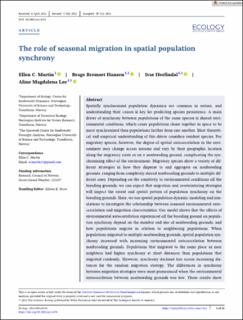| dc.description.abstract | Spatially synchronized population dynamics are common in nature, and understanding their causes is key for predicting species persistence. A main driver of synchrony between populations of the same species is shared environmental conditions, which cause populations closer together in space to be more synchronized than populations further from one another. Most theoretical and empirical understanding of this driver considers resident species. For migratory species, however, the degree of spatial autocorrelation in the environment may change across seasons and vary by their geographic location along the migratory route or on a nonbreeding ground, complicating the synchronizing effect of the environment. Migratory species show a variety of different strategies in how they disperse to and aggregate on nonbreeding grounds, ranging from completely shared nonbreeding grounds to multiple different ones. Depending on the sensitivity to environmental conditions off the breeding grounds, we can expect that migration and overwintering strategies will impact the extent and spatial pattern of population synchrony on the breeding grounds. Here, we use spatial population-dynamic modeling and simulations to investigate the relationship between seasonal environmental autocorrelation and migration characteristics. Our model shows that the effects of environmental autocorrelation experienced off the breeding ground on population synchrony depend on the number and size of nonbreeding grounds, and how populations migrate in relation to neighboring populations. When populations migrated to multiple nonbreeding grounds, spatial population synchrony increased with increasing environmental autocorrelation between nonbreeding grounds. Populations that migrated to the same place as near neighbors had higher synchrony at short distances than populations that migrated randomly. However, synchrony declined less across increasing distances for the random migration strategy. The differences in synchrony between migration strategies were most pronounced when the environmental autocorrelation between nonbreeding grounds was low. These results show the importance of considering migration when studying spatial population synchrony and predicting patterns of synchrony and population viability under global environmental change. Climate change and habitat loss and fragmentation may cause range shifts and changes in migratory strategies, as well as changes in the mean and spatial autocorrelation of the environment, which can alter the scale and patterns observed in spatial population synchrony. | en_US |

